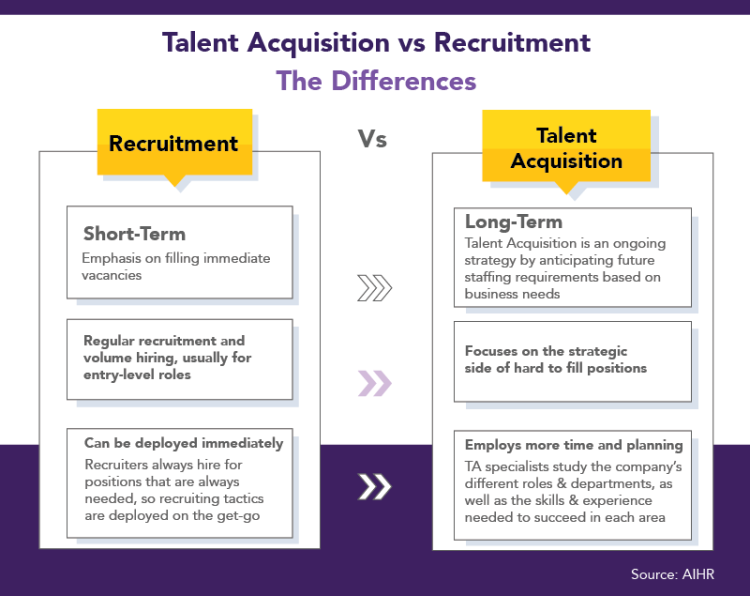What is the Difference Between Talent Acquisition and Recruitment

In human resources, it's essential to recognize the differences between talent acquisition and recruitment to effectively manage a workforce. Recruitment focuses on quickly filling open positions and addressing immediate needs, while talent acquisition takes a strategic approach, planning for long-term goals and seeking out key personnel for ongoing success. This blog will clarify these distinctions and examine how each process contributes to an organization's growth and stability. According to Gartner, companies with advanced talent acquisition strategies can increase new hire retention by 30% and improve the quality of their hires by 18%, highlighting the importance of understanding and optimizing these critical functions.
What is Talent Acquisition?
Talent acquisition refers to the strategic process of identifying and engaging with potential candidates to meet an organization's long-term goals. Unlike routine hiring, talent acquisition focuses on foreseeing future needs and involves attracting highly skilled individuals for positions that play a critical role in the company’s growth and success. This approach is not just about filling positions but building a strong workforce that can drive the organization forward over the years.
Also read: Benefits of modern recruitment software for workforce
What is Recruitment in HR?
Recruitment, on the other hand, is the operational process of filling vacancies as they arise within an organization. It is typically a shorter-term solution, aimed at quickly sourcing candidates to meet immediate staffing needs. The process is highly transactional, focusing on speed and efficiency to minimize the time positions remain unfilled. Recruitment activities are often reactive, responding directly to the pressing needs of the business without the strategic foresight that characterizes talent acquisition.
What are the Differences Between Talent Acquisition and Recruitment?

Scope and Objectives of Talent Acquisition and Recruitment
The scope and objectives of talent acquisition and recruitment vary significantly. Talent acquisition is strategically broad, focusing on long-term human resource planning and the integration of talent to fulfill the future goals of an organization. This involves understanding the evolving needs of the business and preparing to meet these challenges through careful workforce planning and development. In contrast, recruitment is operationally narrow, aimed primarily at filling current vacancies quickly and efficiently to ensure that business operations are not disrupted. The objective here is immediate, with a focus on short-term needs and rapid fulfillment of job openings.
Timeframe and Focus Of talent acquisition and recruitment
Talent acquisition is characterized by a long-term, continuous strategy. It involves building relationships and a strong employer brand over time to attract high-quality candidates for future and strategic roles. This approach requires ongoing engagement and nurturing of potential talent pools, making it fundamentally proactive. On the other hand, recruitment is often reactive, with a focus on immediate action to fill vacancies as they occur. The recruitment process is typically quicker, addressing urgent needs without the prolonged timeline associated with talent acquisition.
Techniques and Tools for talent acquisition versus recruitment
The techniques and tools used in talent acquisition versus recruitment also reflect their different focuses. Talent acquisition relies on tools like employer branding and relationship building to attract potential candidates. These strategies enhance an organization’s image and appeal to prospective employees over time, making it easier to attract top talent when positions become available. Techniques include networking events, talent communities, and social media engagement, which help build a strong talent pipeline. In contrast, recruitment often utilizes job boards, screening interviews, and application tracking systems designed for quick processing and selection. These tools are effective for meeting immediate hiring needs but lack the strategic elements of talent acquisition.
When to Use Talent Acquisition vs. Recruitment
Understanding when to prioritize talent acquisition over recruitment or vice versa can significantly impact an organization's growth and adaptability. Talent acquisition is most suitable in scenarios where the need is strategic, such as filling senior management roles, specialized positions, or planning for future expansions. This approach is crucial in industries that are rapidly evolving or highly competitive, where having the right leaders and innovators can define the company's success. On the other hand, recruitment is more applicable for filling immediate vacancies to ensure business continuity. It is ideal for roles that require less specialization and where the primary goal is to quickly address workforce shortages.
Many organizations benefit from integrating both strategies to create a dynamic HR function. For example, a tech company might use talent acquisition to secure visionary IT specialists and leaders while relying on recruitment to quickly fill customer service or administrative roles as needed.
Integrating Talent Acquisition and Recruitment
Both talent acquisition and recruitment can coexist within a comprehensive human resources strategy, complementing each other to cover all hiring needs. Integrating both allows organizations to balance short-term needs with long-term goals effectively. For instance, while a company works on building a robust employer brand and engaging with potential future leaders (talent acquisition), it can also fill immediate operational roles through active recruitment campaigns. This integration leads to a more robust HR function by ensuring all aspects of workforce management are addressed—from immediate fill-ins to strategic hiring for sustained growth.
The distinction and overlap between talent acquisition and recruitment are crucial for crafting an effective HR strategy. Talent acquisition involves a strategic, long-term approach aimed at building a future-proof workforce, whereas recruitment addresses the immediate hiring needs that ensure operational success. By understanding the difference between HR recruiter responsibilities and talent acquisition strategies, organizations can optimize their workforce management. As HR sector continue to evolve, businesses should reassess their current strategies to ensure they are effectively leveraging both recruitment and talent acquisition to meet both their current and future needs. Encouraging a periodic review of these strategies can help organizations maintain a competitive edge and adapt to changing market demands.
Ready to streamline your talent acquisition and recruitment processes? HONO's HR software is designed to simplify and enhance your HR strategy, allowing for seamless integration of both long-term and immediate hiring needs. By leveraging HONO's innovative tools, your organization can optimize workforce management, enhance employer branding, and engage effectively with potential hires. Don't let complex HR challenges slow down your growth. Discover how HONO can help you build a future-proof workforce and achieve operational excellence. Explore HONO's HR Solutions Now!

Author:
HONO Desk
SUBSCRIBE NEWSLETTER
For HR innovation updates
Download free HR Case Studies





